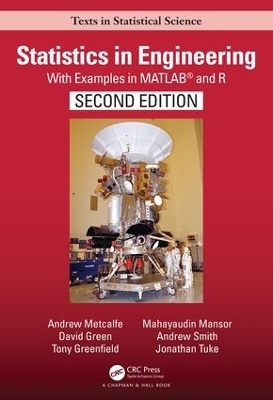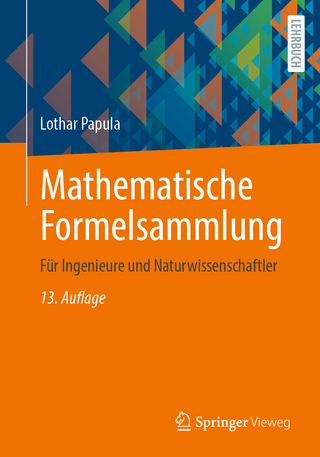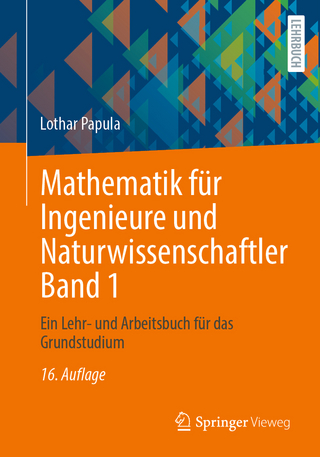
Statistics in Engineering
Chapman & Hall/CRC (Verlag)
978-1-4398-9547-4 (ISBN)
The first eight chapters cover probability and probability distributions, graphical displays of data and descriptive statistics, combinations of random variables and propagation of error, statistical inference, bivariate distributions and correlation, linear regression on a single predictor variable, and the measurement error model. This leads to chapters including multiple regression; comparisons of several means and split-plot designs together with analysis of variance; probability models; and sampling strategies. Distinctive features include:
All examples based on work in industry, consulting to industry, and research for industry.
Examples and case studies include all engineering disciplines.
Emphasis on probabilistic modeling including decision trees, Markov chains and processes, and structure functions.
Intuitive explanations are followed by succinct mathematical justifications.
Emphasis on random number generation that is used for stochastic simulations of engineering systems, demonstration of key concepts, and implementation of bootstrap methods for inference.
Use of MATLAB and the open source software R, both of which have an extensive range of statistical functions for standard analyses and also enable programing of specific applications.
Use of multiple regression for times series models and analysis of factorial and central composite designs.
Inclusion of topics such as Weibull analysis of failure times and split-plot designs that are commonly used in industry but are not usually included in introductory textbooks.
Experiments designed to show fundamental concepts that have been tested with large classes working in small groups.
Website with additional materials that is regularly updated.
Andrew Metcalfe, David Green, Andrew Smith, and Jonathan Tuke have taught probability and statistics to students of engineering at the University of Adelaide for many years and have substantial industry experience. Their current research includes applications to water resources engineering, mining, and telecommunications. Mahayaudin Mansor worked in banking and insurance before teaching statistics and business mathematics at the Universiti Tun Abdul Razak Malaysia and is currently a researcher specializing in data analytics and quantitative research in the Health Economics and Social Policy Research Group at the Australian Centre for Precision Health, University of South Australia. Tony Greenfield, formerly Head of Process Computing and Statistics at the British Iron and Steel Research Association, is a statistical consultant. He has been awarded the Chambers Medal for outstanding services to the Royal Statistical Society; the George Box Medal by the European Network for Business and Industrial Statistics for Outstanding Contributions to Industrial Statistics; and the William G. Hunter Award by the American Society for Quality. Visit their website here: http://www.maths.adelaide.edu.au/david.green/BookWebsite/
I Foundations
Why Understand Statistics?
Introduction
Using the book
Software
Probability and Making Decisions
Introduction
Random digits
Concepts and uses
Generating random digits
Pseudo random digits
Defining probabilities
Defining probabilities {Equally likely outcomes
Defining probabilities {relative frequencies
Defining probabilities {subjective probability and expected monetary value
Axioms of Probability
The addition rule of probability
Complement
Conditional probability
Conditioning on information
Conditional probability and the multiplicative rule
Independence
Tree diagrams
Bayes' theorem
Law of total probability
Bayes' theorem for two events
Bayes' theorem for any number of events
Decision trees
Permutations and combinations
Simple random sample
Summary
Notation
Summary of main results
MATLAB and R commands
Exercises
Graphical Displays of Data and Descriptive Statistics
Types of variables
Samples and populations
Displaying data
Stem-and-leaf plot
Time series plot
Pictogram
Pie chart
Bar chart
Rose plot
Line chart for discrete variables
Histogram and cumulative frequency polygon for continuous variables
Pareto chart
Numerical summaries of data
Population and sample
Measures of location
Measures of spread
Box-plots
Outlying values and robust statistics
Outlying values
Robust statistics
Grouped data
Calculation of the mean and standard deviation for discrete data
Grouped continuous data [mean and sd for grouped continuous data]
Mean as center of gravity
Case study of wave stress on offshore structure
Shape of distributions
Skewness
Kurtosis
Some contrasting histograms
Multivariate data
Scatter plot
Histogram for bivariate data
Parallel coordinates plot
Descriptive time series
Definition of time series
Missing values in time series
Decomposition of time series
Centered moving average
Additive monthly model
Multiplicative monthly model
Seasonal adjustment
Forecasting
Index numbers
Summary
Notation
Summary of main results
MATLAB and R commands
Exercises
Discrete Probability Distributions
Discrete random variables
Definition of a discrete probability distribution
Expected value
Bernoulli trial
Binomial distribution
Introduction
Defining the binomial distribution
A model for conductivity
Random deviates from binomial distribution
Fitting a binomial distribution
Hypergeometric distribution
Defining the hypergeometric distribution
Random deviates from the hypergeometric distribution
Fitting the hypergeometric distribution
Negative binomial distribution
The geometric distribution
Defining the negative binomial distribution
Applications of negative binomial distribution
Fitting a negative binomial distribution
Random numbers from a negative binomial distribution
Poisson process
Defining a Poisson process in time
Superimposing Poisson processes
Spatial Poisson Process
Modifications to Poisson processes
Poisson distribution
Fitting a Poisson distribution
Times between events
Summary
Notation
Summary of main results
MATLAB and R commands
Exercises
Continuous Probability Distributions
Continuous probability distributions
Definition of a continuous random variable
Definition of a continuous probability distribution
Moments of a continuous probability distribution
Median and mode of a continuous probability distribution
Parameters of probability distributions
Uniform distribution
Definition of a uniform distribution
Applications of the uniform distribution
Random deviates from a uniform distribution
Distribution of F(X) is uniform
Fitting a uniform distribution
Exponential distribution
Definition of an exponential distribution
Markov property
Poisson process
Lifetime distribution
Applications of the exponential distribution
Random deviates from an exponential distribution
Fitting an exponential distribution
Normal (Gaussian) distribution
Definition of a normal distribution
The standard normal distribution
Applications of the normal distribution
Random numbers from a normal distribution
Fitting a normal distribution
Probability plots
Quantile-quantile plots
Probability plot
Lognormal distribution
Definition of a lognormal distribution
Applications of the lognormal distribution
Random numbers from lognormal distribution
Fitting a lognormal distribution
Gamma distribution
Definition of a gamma distribution
Applications of the gamma distribution
Random deviates from gamma distribution
Fitting a gamma distribution
Gumbel distribution
Definition of a Gumbel distribution
Applications of the Gumbel distribution
Random deviates from a Gumbel distribution
Fitting a Gumbel distribution
Summary
Notation
Summary of main results
MATLAB and R commands
Exercises
Correlation and Functions of Random Variables
Introduction
Sample covariance and correlation coefficient
Defining sample covariance
Bivariate distributions, population covariance and correlation coefficient
Population covariance and correlation coefficient
Bivariate distributions - discrete case
Bivariate distributions - continuous case
Marginal distributions
Bivariate histogram
Covariate and correlation
Bivariate probability distributions
Copulas
Linear combination of random variables (propagation of error)
Mean and variance of a linear combination of random variables
Bounds for correlation coefficient
Linear combination of normal random variables
Central Limit Theorem and distribution of the sample mean
Non-linear functions of random variables (propagation of error)
Summary
Notation
Summary of main results
MATLAB and R commands
Exercises
Estimation and Inference
Introduction
Statistics as estimators
Population parameters
Sample statistics and sampling distributions
Bias and MSE
Accuracy and precision
Precision of estimate of population mean
Confidence interval for population mean when _ known
Confidence interval for mean when _ unknown
Construction of confidence interval and rationale for the t-distribution
The t-distribution
Robustness
Bootstrap methods
Bootstrap resampling
Basic bootstrap confidence intervals
Percentile bootstrap confidence intervals
Parametric bootstrap
Hypothesis testing
Hypothesis test for population mean when _ known
Hypothesis test for population mean when _ unknown
Relation between a hypothesis test and the confidence interval
P-value
One-sided confidence intervals and one-sided tests
Sample size
Confidence interval for a population variance and standard deviation
Comparison of means
Independent Samples
Population standard deviations differ
Population standard deviations assumed equal
Matched pairs
Comparing variances
Inference about proportions
Single sample
Comparing two proportions
McNemar's test
Prediction intervals and statistical tolerance intervals
Prediction interval
Statistical tolerance interval
Goodness of fit tests
Chi-square test
Empirical distribution function tests
Summary
Notation
Summary of main results
MATLAB and R commands
Exercises
Linear Regression and Linear Relationships
Linear regression
Introduction
The model
Fitting the model
Fitting the regression line
Identical forms for the least squares estimate of the slope
Relation to correlation
Alternative form for the fitted regression line
Residuals
Identities satisfied by the residuals
Estimating the standard deviation of the errors
Checking assumptions A, A and A
Properties of the estimators
Estimator of the slope
Estimator of the intercept
Predictions
Confidence interval for mean value of Y given x
Limits of Prediction
Plotting confidence intervals and prediction limits
Summarizing the algebra
Coefficient of determination R
Regression for a bivariate normal distribution
The bivariate normal distribution
Regression towards the mean
Relationship between correlation and regression
Values of x are assumed to be measured without error and can be preselected
The data pairs are assumed to be a random sample from a bivariate normal distribution
Fitting a linear relationship when both variables are measured with error
Calibration lines
Intrinsically linear models
Summary
Notation
Summary of main results
MATLAB and R commands
Exercises
II Developments
Multiple Regression
Introduction
Multivariate data
Multiple regression model
The linear model
Random vectors
Definition
Linear transformations of a random vector
Multivariate normal distribution
Matrix formulation of the linear model
Geometrical interpretation
Fitting the model
Principle of least squares
Multivariate calculus - three basic results
The least squares estimator of the coefficients
Estimating the coefficients
Estimating the standard deviation of the errors
Standard errors of the estimators of the coefficients
Assessing the fit
The residuals
R-squared
F-statistic
Cross validation
Predictions
Building multiple regression models
Interactions
Categorical variables
F-test for an added set of variables
Quadratic terms
Guidelines formatting regression models
Time series
Introduction
Aliasing and sampling intervals
Fitting a trend and seasonal variation with regression
Autocovariance and autocorrelation
Defining autocovariance for a stationary times series model
Defining sample autocovariance and the correlogram
Autoregressive models
AR() and AR() models
Non-linear least squares
Generalized linear model
Logistic regression
Poisson regression
Summary
Notation
Summary of main results
MATLAB and R commands
Exercises
Statistical Quality Control
Continuous improvement
Defining quality
Taking measurements
Avoiding rework
Strategies for quality improvement
Quality management systems
Implementing continuous improvement
Process stability
Runs chart
Histograms and boxplots
Components of variance
Capability
Process capability index
Process performance index
One-sided process capability indices
Reliability
Introduction
Reliability of components
Reliability function and the failure rate
Weibull analysis
Definition of the Weibull distribution
Weibull quantile plot
Censored data
Maximum likelihood
Kaplan-Meier estimator of reliability
Acceptance sampling
Statistical quality control charts
Shewhart mean and range chart for continuous variables
Mean chart
Range chart
p-charts for proportions
c-charts for counts
Cumulative sum charts
Multivariate control charts
Summary
Notation
Summary of main results
MATLAB and R commands
Exercises
Design of Experiments with Regression Analysis
Introduction
Factorial designs with factors at two levels
Full factorial designs
Setting up a k design
Analysis of k design
Fractional factorial designs
Central composite designs
Evolutionary operation (EVOP)
Summary
Notation
Summary of main results
MATLAB and R commands
Exercises
Design of Experiments and Analysis of Variance
Introduction
Comparison of several means with one-way ANOVA
Defining the model
Multiple comparisons
One-way ANOVA
Testing HO
Follow up procedure
Two factors at multiple levels
Two factors without replication (two-way ANOVA)
Two factors with replication (three-way ANOVA)
Randomized block design
Split plot design
Summary
Notation
Summary of main results
MATLAB and R commands
Exercises
Probability Models
System Reliability
Series system
Parallel system
k-out-of-n system
Modules
Duality
Paths and Cut sets
Reliability function
Redundancy
Non-repairable systems
Standby systems
Common cause failures
Reliability bounds
Markov chains
Discrete Markov chain
Equilibrium Behavior of irreducible Markov Chains
Methods for solving equilibrium equations
Absorbing Markov Chains
Markov Chains in continuous time
Simulation of systems
The simulation procedure
Drawing inference from simulation outputs
Variance reduction
Summary
Notation
Summary of main results
MATLAB and R commands
Exercises
Sampling Strategies
Introduction
Simple random sampling from a finite population
Finite population correction
Randomization theory
Defining the simple random sample
Mean and variance of sample mean
Mean and variance of estimator of population total
Model based analysis
Sample size
Stratified sampling
Principle of stratified sampling
Estimating the population mean and total
Optimal allocation of the sample over strata
Multi-stage sampling
Quota sampling
Ratio estimators and regression estimators
Introduction
Regression estimators
Ratio estimator
Calibration of the unit cost data base
Sources of error in an AMP
Calibration factor
Summary
Notation
Summary of main results
MATLAB and R commands
Exercises
A Notation
B Glossary
C Data
D Getting started in R
E Getting started in MATLAB
F Experiments
G Mathematical explanations of key results
H MATLAB code for selected Figures
I Statistical Tables
| Erscheinungsdatum | 02.02.2019 |
|---|---|
| Reihe/Serie | Chapman & Hall/CRC Texts in Statistical Science |
| Zusatzinfo | 100 Illustrations, black and white |
| Sprache | englisch |
| Maße | 178 x 254 mm |
| Gewicht | 1670 g |
| Themenwelt | Mathematik / Informatik ► Mathematik ► Angewandte Mathematik |
| Mathematik / Informatik ► Mathematik ► Statistik | |
| Mathematik / Informatik ► Mathematik ► Wahrscheinlichkeit / Kombinatorik | |
| Naturwissenschaften ► Geowissenschaften ► Geologie | |
| ISBN-10 | 1-4398-9547-3 / 1439895473 |
| ISBN-13 | 978-1-4398-9547-4 / 9781439895474 |
| Zustand | Neuware |
| Informationen gemäß Produktsicherheitsverordnung (GPSR) | |
| Haben Sie eine Frage zum Produkt? |
aus dem Bereich


